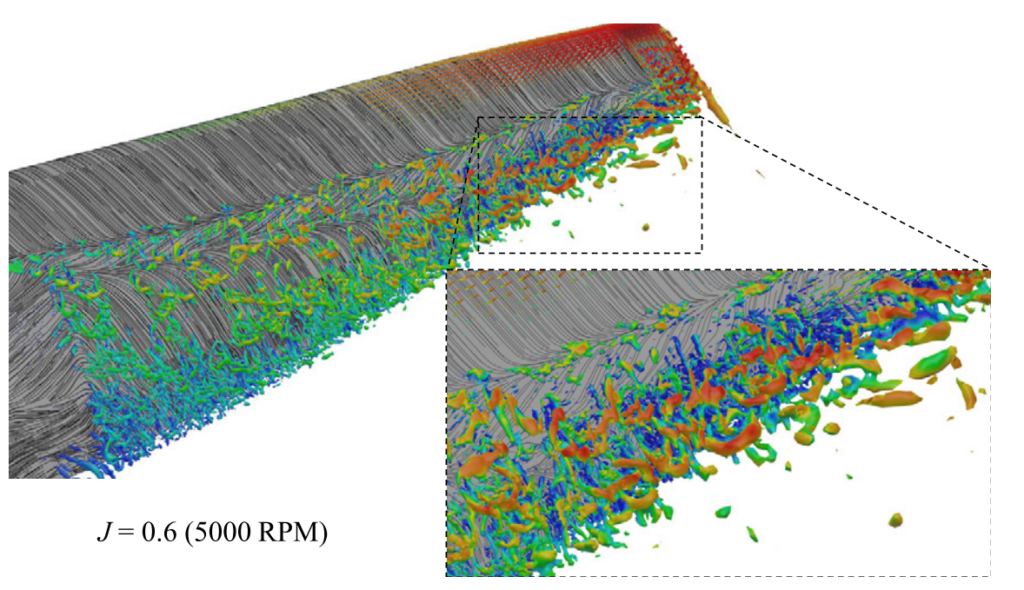
27 Dec Laminar Separation in PowerFLOW
What is Laminar Separation?
Laminar separation occurs when the flow transitions from a smooth, ordered, and layered (laminar) state to a more chaotic and disordered (turbulent) state. This transition is often associated with changes in the local flow conditions, such as adverse pressure gradients, curvature of the surface, or the presence of obstacles. When these conditions are unfavorable, the laminar boundary layer may separate from the surface, leading to a disruption in the smooth flow of the fluid.
One common place where this transition is critical is around relatively slow-moving propeller or fan blades, such as found on electric vertical takeoff and landing (eVTOL) craft and wind turbines. The speed and scale of these mean that they have a relatively low chord Reynolds number, below one milion. This can lead to a complicated boundary layer behavior – laminar flow on the leading edge separates, travels over the blade in a laminar separation bubble, and then reattaches at the trailing edge.

Figure 1: Simulated flow over a small propeller blade, showing laminar flow on the leading edge, attached turbulent flow near the trailing edge, and a laminar separation bubble (LSB) between the two.
This doesn’t only affect the aerodynamics of a propeller – the interface where the airflow over both sides of the blades meet and reattach is also one the main sources of blade noise. Accurate noise simulation also requires modeling the laminar separation and reattachment.
Applications of Laminar Separation Simulation
Interest in electric vertical takeoff and landing (eVTOL) aircraft is growing as a means to revolutionize urban air mobility. While quadcopter-type drones are already commonplace, the potential of larger eVTOL vehicles spans from logistical applications to serving as aerial taxis. The key to their success lies in their ability to navigate safely within urban environments and maintain noise levels acceptable to local residents.
In the realm of eVTOL, the propellers exhibit relatively slow rotations, especially when compared to traditional aircraft. In this operational range, the Reynolds number for the propeller blades is sufficiently low to give rise to laminar separation bubbles. Accurately modeling these phenomena is essential for understanding the intricacies of thrust, drag, and noise production.
Laminar separation is not unique to eVTOL; it is also a significant factor in applications such as wind turbines. The slow rotation of wind turbine blades, typically only a few revolutions per minute (RPM), results in a low Reynolds number. Laminar separation from these blades can generate significant noise, a concern that has a negative impact on local communities. This noise issue is a primary cause for objections to new wind farm projects. Therefore, a comprehensive understanding of laminar flow separation and reattachment is imperative for the successful design of wind turbines that are both efficient and environmentally acceptable.
Laminar Flow Simulation and the Turbulent Model Extension
PowerFLOW has established itself as an industry benchmark for aerodynamic and aeroacoustic simulation, renowned for its automatic grid generation, streamlined automation, and scalability features that enhance simulation setup. Its robust particle-based solver incorporates Very Large Eddy Simulation (VLES) turbulence models.
Previously, simulating transition effects required users to manually incorporate trip elements into the model to emulate the separation effect. However, SIMULIA PowerFLOW now introduces an advanced technology that provides a swift and precise approach for automatically simulating laminar separation: the turbulence model extension to PowerFLOW VLES.
PowerFLOW uses the Lattice Boltzmann method to calculate fluid flows, specifically the VLES method, which is well suited to turbulent flows. The new version extends the Lattice Boltzmann VLES method to cover the laminar-to-turbulent transition so these can also be captured in the same simulation. This can simulate both airflow and noise from the laminar-turbulent transition regime.
The accuracy of the turbulent model extension has been verified experimentally. A propeller was constructed and rotated so that the chord-based Reynolds number was on the order of 7×104. At this speed, a significant laminar separation bubble was observed. As shown in Figures 2 and 3, PowerFLOW provides excellent agreement to measured velocity and noise around the blade. VLES with the transition model extension was more accurate than using a geometric “trip” to force the separation. For more information about this, you can find the full published results in “Lattice-Boltzmann calculations of rotor aeroacoustics in transitional boundary layer regime” in Aerospace Science and Technology, Volume 130, November 2022, 107953.

Figure 2: Time-averaged velocity magnitude around an airfoil measured experimentally (left) and calculated with VLES in PowerFLOW (right).

Figure 3: Far-field noise for in-plane (Mic. 7) and out-of-plane (Mic. 11) observers, measured and simulated.
Laminar transition powerflow conclusion
At lower Reynolds numbers, the impact of laminar flow becomes significant, leading to the formation of laminar separation bubbles and heightened noise levels. Notable instances of this occurrence include the airflow around eVTOL rotors and wind turbine blades. Historically, simulating this transition has posed challenges.
The PowerFLOW VLES (Very Large Eddy Simulation) turbulence model extension adeptly addresses the transition between laminar and turbulent flow with efficiency and precision. This extension proves beneficial in aerodynamics and aeroacoustics simulations, offering accelerated simulation setup and enabling the modeling of scenarios that were previously challenging to simulate.
Do you need more info?
If you need more info, do not hesitate to contact us or write us an email to sales@4realsim.com


